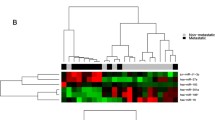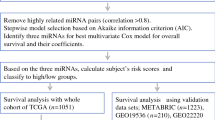Abstract
We evaluated suggested metastasis-related microRNAs (miRNAs) for their associations with disease-free survival (DFS) and overall survival (OS) of triple-negative breast cancer (TNBC). In a cohort of 456 TNBC cases, we systematically evaluated 57 previously reported metastasis-related miRNAs in tumor tissue using the NanoString nCounter assay. Cox regression was applied to evaluate miRNA expression in association with DFS and OS. In vitro assays using the TNBC cell line MDA-MB-231 were also conducted to validate epidemiological study findings. During a median follow-up of 5.3 years, 112 deaths and 97 recurrences were documented. High levels of miR-374b-5p, miR-218-5p, or miR-126-3p, or low levels of miR-27b-3p were independently associated with a favorable TNBC outcome (P < 0.01 for all). A composite score based on the levels of these four miRNAs was associated with DFS, with hazard ratios (95 % confidence interval) of 0.70 (0.43–1.15), 0.51 (0.29–0.90), and 0.18 (0.09–0.37) for the second, third, and fourth compared to the lowest quartile. Incorporating the miRNA score with known TNBC outcome predictors, i.e., age at diagnosis, tumor stage, and basal-like subtype, increased the C-index for predicting DFS from 0.68 to 0.74. Additionally, miR-126-3p was correlated with basal-like breast cancer, and miR-374b-5p modified the therapeutic effects of 5-Fluorouracil and Cyclophosphamide treatments in basal-like breast cancer patients. Restoring miR-126-3p, miR-218-5p, or miR-374b-5p, or inhibiting miR-27b-3p in MDA-MB-231 cells reduced cell proliferation. miR-374b-5p suppressed cell invasion and miR-218-5p inhibited colonization. This study provides strong evidence that the expression levels of miR-374b-5p, miR-27b-3p, miR-126-3p, and miR-218-5p in tumor tissues predict TNBC outcomes.



Similar content being viewed by others
References
Ossovskaya V, Wang Y, Budoff A et al (2011) Exploring molecular pathways of triple-negative breast cancer. Genes Cancer 2:870–879. doi:10.1177/1947601911432496
Dent R, Trudeau M, Pritchard KI et al (2007) Triple-negative breast cancer: clinical features and patterns of recurrence. Clin Cancer Res Off J Am Assoc Cancer Res 13:4429–4434. doi:10.1158/1078-0432.CCR-06-3045
Lim LP, Lau NC, Garrett-Engele P et al (2005) Microarray analysis shows that some microRNAs downregulate large numbers of target mRNAs. Nature 433:769–773. doi:10.1038/nature03315
Bartel DP (2004) MicroRNAs: genomics, biogenesis, mechanism, and function. Cell 116:281–297. doi:10.1016/S0092-8674(04)00045-5
Kumar MS, Lu J, Mercer KL et al (2007) Impaired microRNA processing enhances cellular transformation and tumorigenesis. Nat Genet 39:673–677. doi:10.1038/ng2003
Iorio MV, Ferracin M, Liu C-G et al (2005) MicroRNA gene expression deregulation in human breast cancer. Cancer Res 65:7065–7070. doi:10.1158/0008-5472.CAN-05-1783
Calin GA, Ferracin M, Cimmino A et al (2005) A microRNA signature associated with prognosis and progression in chronic lymphocytic leukemia. N Engl J Med 353:1793–1801. doi:10.1056/NEJMoa050995
Calin GA, Croce CM (2006) MicroRNA signatures in human cancers. Nat Rev Cancer 6:857–866. doi:10.1038/nrc1997
Yu S-L, Chen H-Y, Chang G-C et al (2008) MicroRNA signature predicts survival and relapse in lung cancer. Cancer Cell 13:48–57. doi:10.1016/j.ccr.2007.12.008
Cai J, Guan H, Fang L et al (2013) MicroRNA-374a activates Wnt/β-catenin signaling to promote breast cancer metastasis. J Clin Invest 123:566–579. doi:10.1172/JCI65871
Cascione L, Gasparini P, Lovat F et al (2013) Integrated microRNA and mRNA signatures associated with survival in triple negative breast cancer. PLoS One 8:e55910. doi:10.1371/journal.pone.0055910
Png KJ, Halberg N, Yoshida M, Tavazoie SF (2012) A microRNA regulon that mediates endothelial recruitment and metastasis by cancer cells. Nature 481:190–194. doi:10.1038/nature10661
Tavazoie SF, Alarcón C, Oskarsson T et al (2008) Endogenous human microRNAs that suppress breast cancer metastasis. Nature 451:147–152. doi:10.1038/nature06487
Volinia S, Galasso M, Sana ME et al (2012) Breast cancer signatures for invasiveness and prognosis defined by deep sequencing of microRNA. Proc Natl Acad Sci 109:3024–3029. doi:10.1073/pnas.1200010109
Zhang Y, Yang P, Sun T et al (2013) miR-126 and miR-126* repress recruitment of mesenchymal stem cells and inflammatory monocytes to inhibit breast cancer metastasis. Nat Cell Biol 15:284–294. doi:10.1038/ncb2690
Ma L, Teruya-Feldstein J, Weinberg RA (2007) Tumour invasion and metastasis initiated by microRNA-10b in breast cancer. Nature 449:682–688. doi:10.1038/nature06174
Jin L, Wessely O, Marcusson EG et al (2013) Prooncogenic Factors miR-23b and miR-27b Are Regulated by Her2/Neu, EGF, and TNF-α in breast cancer. Cancer Res 73:2884–2896. doi:10.1158/0008-5472.CAN-12-2162
Gasparini P, Cascione L, Fassan M et al (2014) MicroRNA expression profiling identifies a four microRNA signature as a novel diagnostic and prognostic biomarker in triple negative breast cancers. Oncotarget 5:1174–1184
Shu XO, Zheng Y, Cai H et al (2009) Soy food intake and breast cancer survival. JAMA 302:2437–2443. doi:10.1001/jama.2009.1783
Su Y, Zheng Y, Zheng W et al (2011) Distinct distribution and prognostic significance of molecular subtypes of breast cancer in Chinese women: a population-based cohort study. BMC Cancer 11:292. doi:10.1186/1471-2407-11-292
Geiss GK, Bumgarner RE, Birditt B et al (2008) Direct multiplexed measurement of gene expression with color-coded probe pairs. Nat Biotechnol 26:317–325. doi:10.1038/nbt1385
Waggott D, Chu K, Yin S et al (2012) NanoStringNorm: an extensible R package for the pre-processing of NanoString mRNA and miRNA data. Bioinforma Oxf Engl 28:1546–1548. doi:10.1093/bioinformatics/bts188
Parker JS, Mullins M, Cheang MCU et al (2009) Supervised risk predictor of breast cancer based on intrinsic subtypes. J Clin Oncol Off J Am Soc Clin Oncol 27:1160–1167. doi:10.1200/JCO.2008.18.1370
Guo C, Sah FJ, Beard L et al (2008) The non-coding RNA, miR-126, suppresses the growth of neoplastic cells by targeting phosphatidylinositol 3-Kinase signaling and is frequently lost in colon cancers. Genes Chromosom Cancer 47:939–946. doi:10.1002/gcc.20596
Feng R, Chen X, Yu Y et al (2010) miR-126 functions as a tumour suppressor in human gastric cancer. Cancer Lett 298:50–63. doi:10.1016/j.canlet.2010.06.004
Zhu N, Zhang D, Xie H et al (2011) Endothelial-specific intron-derived miR-126 is down-regulated in human breast cancer and targets both VEGFA and PIK3R2. Mol Cell Biochem 351:157–164. doi:10.1007/s11010-011-0723-7
Hebbard LW, Maurer J, Miller A et al (2010) Maternal embryonic leucine zipper kinase is upregulated and required in mammary tumor-initiating cells in vivo. Cancer Res 70:8863–8873. doi:10.1158/0008-5472.CAN-10-1295
Dallol A, Silva NFD, Viacava P et al (2002) SLIT2, a human homologue of the drosophila slit2 gene, has tumor suppressor activity and is frequently inactivated in lung and breast cancers. Cancer Res 62:5874–5880
Png KJ, Yoshida M, Zhang XH-F et al (2011) MicroRNA-335 inhibits tumor reinitiation and is silenced through genetic and epigenetic mechanisms in human breast cancer. Genes Dev 25:226–231. doi:10.1101/gad.1974211
Acknowledgments
This work was supported by the Department of Defense Breast Cancer Research Program (DAMD 17-02-1-0607); the National Institutes of Health (R01CA118229, P50CA098131); and the Vanderbilt Molecular and Genetic Epidemiology of Cancer training program (R25CA160056 to Yan Liu). RNA sample preparation was conducted at the Survey and Biospecimen Shared Resources, supported in part by the Vanderbilt-Ingram Cancer Center (P30CA068485).
Conflict of interest
The authors declare that they have no conflict of interest.
Author information
Authors and Affiliations
Corresponding author
Electronic supplementary material
Below is the link to the electronic supplementary material.
Rights and permissions
About this article
Cite this article
Liu, Y., Cai, Q., Bao, PP. et al. Tumor tissue microRNA expression in association with triple-negative breast cancer outcomes. Breast Cancer Res Treat 152, 183–191 (2015). https://doi.org/10.1007/s10549-015-3460-x
Received:
Accepted:
Published:
Issue Date:
DOI: https://doi.org/10.1007/s10549-015-3460-x




